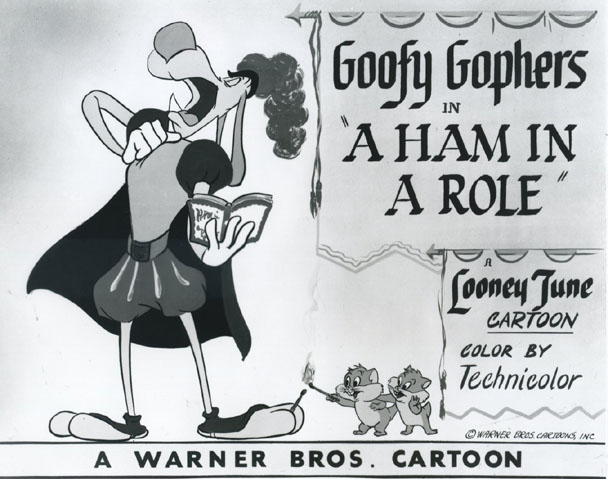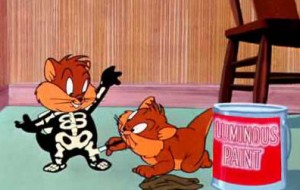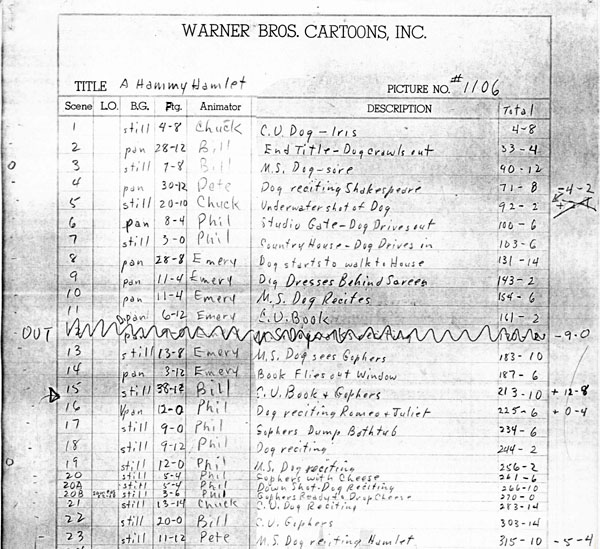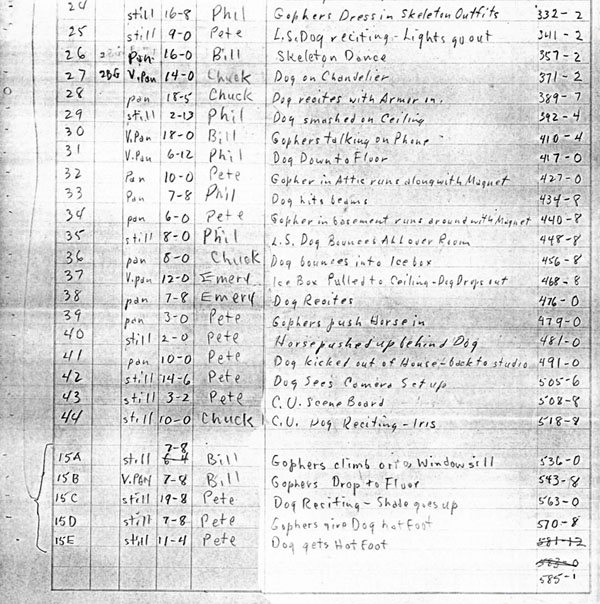
In this week’s breakdown: a Shakespearian hound and the Goofy Gophers!
The working title for this cartoon is A Hammy Hamlet, as listed on the original studio draft. This straightforward title is more in the Terrytoons vein — maybe a pastiche of stage theatrics featuring Heckle and Jeckle — while the jargon of the finished cartoon packs a bigger punch. You’ll notice on the draft that scene 15 has additional scenes – the Gophers’ first acts of retaliation against the Shakespearian dog — inserted at the bottom of the document. It’s intriguing to picture a transition between the Gophers concocting of their plan to them pouring a tubful of bath water into the dog’s mouth. Without them, the cartoon wouldn’t have a ubiquitous “hot-foot” to execute — an irresistible gag when the opportunity emerges, as it does here.
Art Davis was slated to direct A Ham in a Role, as he used a similar eloquent hound in Two Gophers from Texas, released a year earlier. The decision to disband Davis’ directorial unit took effect during production, by November 1947. Davis and his unit were under the same six-month probationary contract given to Bob Clampett before he departed the studio. The records for ‘40s Warners cartoons after April 1947 are spotty. Luckily, a surviving dialogue record indicates that a voice session took place on November 15, 1947 (listing Stan Freberg) — two years before its December 1949 release. Mel Blanc might’ve recorded his lines that day as well, but no information survives on whether Blanc and Freberg worked together or separately. By the time of this cartoon’s release, Davis served as an animator in Friz Freleng’s unit.
 Bob McKimson finished the cartoon, recruiting former Davis animators Bill Melendez and Emery Hawkins to his unit.A Ham in a Role, as it stands, feels more like a Davis-directed cartoon in its structure, as the Goofy Gophers heckle the dog in accordance with the Bard’s quotations he recites (selections from Hamlet, Julius Caesar, Romeo and Juliet, Richard III and King Lear). While the gags in the body of the cartoon are clever, they’re too isolated, and they lack a rhythmic flow. McKimson’s handling of the cartoon transpired as he began to fully control his animators, forcing them to adhere to his character layouts, which nearly sapped the individuality out of their work. His brother Charles’ animation drew closer to the director’s inclinations, but there are exceptions. The fluid animation of drifting animator Emery Hawkins was too wild to contain, even at other animation studios. Likewise for Pete Burness’ bouncy work and Melendez’s subdued Scribner-esque animation (a natural influence—he was Scribner’s assistant in the early ‘40s).
Bob McKimson finished the cartoon, recruiting former Davis animators Bill Melendez and Emery Hawkins to his unit.A Ham in a Role, as it stands, feels more like a Davis-directed cartoon in its structure, as the Goofy Gophers heckle the dog in accordance with the Bard’s quotations he recites (selections from Hamlet, Julius Caesar, Romeo and Juliet, Richard III and King Lear). While the gags in the body of the cartoon are clever, they’re too isolated, and they lack a rhythmic flow. McKimson’s handling of the cartoon transpired as he began to fully control his animators, forcing them to adhere to his character layouts, which nearly sapped the individuality out of their work. His brother Charles’ animation drew closer to the director’s inclinations, but there are exceptions. The fluid animation of drifting animator Emery Hawkins was too wild to contain, even at other animation studios. Likewise for Pete Burness’ bouncy work and Melendez’s subdued Scribner-esque animation (a natural influence—he was Scribner’s assistant in the early ‘40s).
Sid Marcus’ animation began when he joined Associated Animators, animating on the Mutt and Jeff cartoons (1925-26) with Dick Huemer, Ben Harrison and Manny Gould. Marcus went to Fleischer’s for a brief period, but switched over to the Mintz studio, where he spent more than a decade. During the ‘30s, while Harrison and Gould worked on Krazy Kat, he contributed to Toby the Pup, Scrappy and the Color Rhapsodies, along with Huemer and Art Davis. Marcus became a director at the studio, and remained during the new Screen Gems designation, directing the Phantasies and several one-shot Color Rhapsodies. He also served as a writer, mostly on the Fox and the Crow series.
 Marcus briefly worked at Warners in the Davis unit, after writer Lloyd Turner left the studio in 1947. His credit is seen in Davis’ last finished cartoon Bye Bye Bluebeard. Marcus was laid off when the unit dissolved. He joined the staff again in the early ‘50s, contributing eccentric titles during his second stint for Bob McKimson; The Oily American, Lighthouse Mouse, Dime to Retire, The Hole Idea, and Devil May Hare — the debut of the Tasmanian Devil — among them. He directed for Lantz on entries released 1963-66 – among them, the cult classic, Half-Baked Alaska (1965) — with Art Davis, who had left Warners after 20 years, as his main animator. Marcus transitioned to television, working on stories for Joe Oriolo’s Felix the Cat series, directing for the notorious Sam Singer on Sinbad Jr. and superhero fare for Grantray-Lawrence (Iron Man, Hulk, and Captain America) and Steve Krantz (Spider-Man). His last work in animation was as a writer and director for De-Patie/Freleng, until his death in 1979.
Marcus briefly worked at Warners in the Davis unit, after writer Lloyd Turner left the studio in 1947. His credit is seen in Davis’ last finished cartoon Bye Bye Bluebeard. Marcus was laid off when the unit dissolved. He joined the staff again in the early ‘50s, contributing eccentric titles during his second stint for Bob McKimson; The Oily American, Lighthouse Mouse, Dime to Retire, The Hole Idea, and Devil May Hare — the debut of the Tasmanian Devil — among them. He directed for Lantz on entries released 1963-66 – among them, the cult classic, Half-Baked Alaska (1965) — with Art Davis, who had left Warners after 20 years, as his main animator. Marcus transitioned to television, working on stories for Joe Oriolo’s Felix the Cat series, directing for the notorious Sam Singer on Sinbad Jr. and superhero fare for Grantray-Lawrence (Iron Man, Hulk, and Captain America) and Steve Krantz (Spider-Man). His last work in animation was as a writer and director for De-Patie/Freleng, until his death in 1979.
The opening tirade in A Ham in a Role, as the thespian dog desires to unshackle himself from clownish animated antics to greener pastures of culture, bears a striking similarity to the plights of ex-Disney animators like Bill Melendez. They conformed to their individualistic perspectives in animation design, while eschewing broad violence at the studio that would become United Productions of America (UPA). Melendez worked at Disney’s in the late ‘30s as an assistant animator, but left during the 1941 strike. He became an animator at Warners under Clampett, Davis and McKimson, but producer Eddie Selzer soon fired him over political beliefs. He transferred to UPA, where he collaborated on their groundbreaking efforts such as Gerald McBoing Boing, Madeline and Christopher Crumpet. Melendez worked on commercials for the studio, Playhouse Pictures, and John Sutherland Productions before founding his own production company, which was entrusted to adapt Charles Schulz’s Peanuts characters to television.
On a film-related note, A Ham in a Role’s production coincided with the American premieres of two Shakespeare adaptations in the fall of 1948, helmed by two directors better qualified in dramatic acting than the “hammy Hamlet” in this cartoon — Laurence Olivier’s Hamlet and Orson Welles’ Macbeth. Olivier received an Oscar for Best Actor and his film won Best Picture of the year.
In the manner of the Goofy Gophers: do you think you should enjoy this breakdown video? Surely! Let’s do!
This week you’ll have to watch it via another link. CLICK HERE.


(Thanks to Jerry Beck, Michael Barrier, Frank Young, Keith Scott and Thad Komorowski for their help.)


 DEVON BAXTER is a film restoration artist, video editor, and animation researcher/writer currently residing in Pennsylvania. He also hosts a
DEVON BAXTER is a film restoration artist, video editor, and animation researcher/writer currently residing in Pennsylvania. He also hosts a 





















































































The opening minute of the cartoon is a brilliant self-critique/parody of everything that those supporting ‘responsible’ entertainment in animation have tried to push on the public from 1947 to this day. It deservedly made it into CBS’ special on the 50th anniversary of the birth of Termite Terrace in 1985. The rest of the cartoon, compared to Davis’ first two efforts with the Gophers, suffers from McKimson’s growing desire to tone things down and lay out everything that’s going to happen in the cartoon, instead of just having things come from out of nowhere.
The initial two efforts with the Gophers had segmented bits, but there was a manic energy to them that pushed the cartoon forward and left you little time to think about how well the gags fit together. Here, Marcus’ pairing of gags with Shakespearean lines is clever, but in several cases (not all) we’re left with too big a gap between the gags (as well as the comedy gap before we get to the gags, where for some reason Bob decided to show the Gophers’ entire walk to the building, instead of just doing a quick cut after a first 1-2 steps).
Honestly, I find this to be a great cartoon anyway and am getting tired of McKimson getting a bad rep from some people especially this cartoon that was done early in his career.
People, seem to expect everyone to be a Jones or Clampett…..
Oh, I think the cartoon has one of the funniest openings ever, and the ending brings us full circle from that perfectly. It’s just that Bob tended to be a little more grounded in his characters actions than what Davis had been with them (or Clampett, who began work on the first Gopher ‘toon). Art didn’t have a problem with a bow tie magically appearing on the dog, and musical instruments appearing around him for the end gag of “Two Gophers from Texas”; Bob liked his gags to be a little less out of nowhere and a little more based on personality animation. Gags have to happen for a reason most of the time in a McKimson cartoon (which isn’t a problem, as long as the gags make the payoff worth the slightly longer wait).
Sounds almost like when the Marx Brothers moved from Paramount to MGM – the latter studio wanted their gags more “grounded”- for instance, when Harpo attacks something with an axe, it has to be one laying nearby, not pulled out of his coat.
The “entire walk to the building” you mention is a fascinating part of this cartoon, but I think it’s there for a reason, if a subversive one. Surely, it’s to hammer home that the two gophers are gay, which may have been intended as a bit of an inside joke to the makers of this series of cartoons. We know they did things that made THEM laugh and maybe we’d “get it”.
I never thought of the Gophers as Warners’ answer to HECKLE AND JECKLE, but I can understand that now, only in this case, both Gophers deliver their violence eagerly and politely. This is where Mel Blanc’s thesbian tendencies with some of his characters really work well. I like the use of sound effects in some portions of this cartoon, too. Can’t beat Tregg Brown!
This is the first I’ve heard of Melendez being fired from WB, especially for something as random as “political beliefs”. Anybody know specifics?
Of all things, I heard that the catalyst was that Melendez asked for a day off, didn’t get it, took it anyway, and got fired. Possibly an excuse to get rid of an employee management didn’t like.
Eric has the story right. I heard it straight from Melendez himself. It was a family issue and Selzer denied him the day off. As for Melendez’ political beliefs, I heard them from Melendez himself too, and they are not popular American views today but were practically criminalized in the post-war USA period. If he were dismissed from anywhere, it would have been from UPA. In my talk with him in 1998, he reflected that perhaps he had taken his politics a little too far at the time and this was the reason that he either resigned from there or was forced out. Bill had little patience for “middle of the roaders”, and there were some prominent ones in the animation business who portrayed themselves as political icons. Melendez’ political views were consistent into his later years, from what I gleaned from our lengthy discussion. I am so glad he was not a victim of the blacklist and that I had that rare opportunity to spend a whole day with him. When I had met him before (in 1991) he shut down my questions about Warner Bros. Cartoons, so it came as a bit of a surprise that he agreed to talk about them in 1998.
I wonder why they used the Looney Tunes name with the Merrie Melodies theme music in the “That’s all, Folks” card at the beginning.
Perhaps Carl Stalling felt that “Merrily We Roll Along” worked better in a truncated version than “The Merry-Go-Round Broke Down.”
Love the scene where one of the Goofy Gophers dressed up as a skeleton and using glow in the. Dark paint did a little dance and striptease to spook the thespian dog.
Also the thespian dog’s tirade against “Low Brow Comedy” in favor for the “High Drama” of William Shakespeare (guess he never heard of Shakespeare’s classic comedies like All’s Well That Ends Well, The Taming of the Shrew, The Tempest,A Midsummer Night’s Dream,Much Ado About Nothing and others) reminded me of The Simpsons Sideshow Bob Terwilleger and his rant on doing the fall guy for Krusty the Clown and rather do some serious works like Shakespeare and others.
In Beck & Friedwald, this is listed as one of McKimson’s best, and I would tend to agree. In some ways, it shot slightly higher than the average theatrical cartoon, what with the quotations. And the first minute/minute-and-a-half is priceless.
Is it just be, or did Nickelodeon show this one at least a thousand times when it had it’s Looney Tunes bloc? Either way, it was one of their more oft repeated shorts.
As a kid in the 80’s, this one was also giving repeated viewings for being one of the non-network WB cartoons used in syndie packages stations would run, though I do recall one station cutting out that first minute or so just so the dog immediately got out into the country than to show him in his former line of work.
Any particular reason why you removed the cartoon from DailyMotion?
DM rejected the video, so I used Google Drive in its place.
Bob McKimson gave a lot of the gopher scenes to Bill Melendez, including that great one where they walk over to the house arm in arm. The gag running through these cartoons is that they’re gay (a conclusion I came to well into adulthood).
It is pretty subtle.
In case it goes unstated…The animation in this cartoon is absolutely top drawer.
It also has a great soundtrack, weaving in tons of songs in just seven minutes: http://imdb.com/title/tt0041443/soundtrack . My personal favorite is “There’s Music in the Land” when the gophers head into the house.
You can also hear “My Merry Oldsmobile” when the dog drives up to his house. (Fleischer’s did a bouncing ball cartoon with this song.)
Interesting those apparently added scenes at 15.